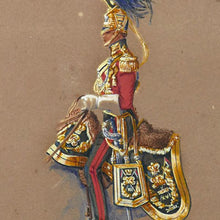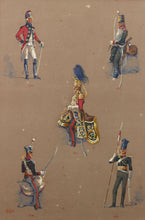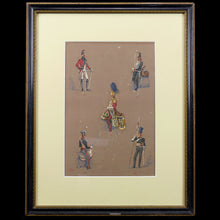16th (The Queen’s) Lancers - Uniform Vignettes, 1890
- Regular price
- £495
- Sale price
- £495
- Regular price
-
- Unit price
- /per
Adding product to your cart
Overall: 52cm (20.5in) x 42cm (16.5in)
Studies of 16th Lancers uniforms from 1768 to 1829 depicting orders of dress. Initialled ‘RW’ for Reginald Wymer lower left. Framed and glazed.
Major Reginald Augustus Wymer (1849-1935) was by turns a soldier, artist, Deputy-Chief Constable of Hertfordshire and father to a wayward son. Born in Upper Berkeley Street, Westminster, the youngest son of General Sir George Wymer, K.C.B., and his wife Emily, daughter of Sir C.F. Crespigny, he was a commissioned into the 91st (Argyllshire) Highlanders in 1870. He gave early proof to his creative talents by designing costumes for the D’Oyly Carte comic opera Ruddigore that premiered at the Savoy Theatre in 1887. The problems with his son, also named Reginald, began after the latter’s return from the South African War and the pawning of a diamond brooch belonging to an actress. A widely reported court case ensued in which the penniless Reginald junior, a former subaltern in the Argyll & Sutherland Highlanders, was found to be the guilty party. Reginald junior’s troubles continued with his attempts to earn a living by betting on horses, and peaked with a sentence of three months’ hard labour for trying to defraud a clergyman. Throughout these dramas, Wymer senior continued as a reserve officer of the 3rd Bn. Queen's Own Cameron Highlanders. He retired from the Army in 1905, but returned during the First World War as a captain on the General List. His military pictures were widely collected, and his patrons included Queen Victoria, Edward VII and Queen Mary, who on 28 May 1932 visited Fortnum & Mason 'to see charming pictures by Major Wymer'.






